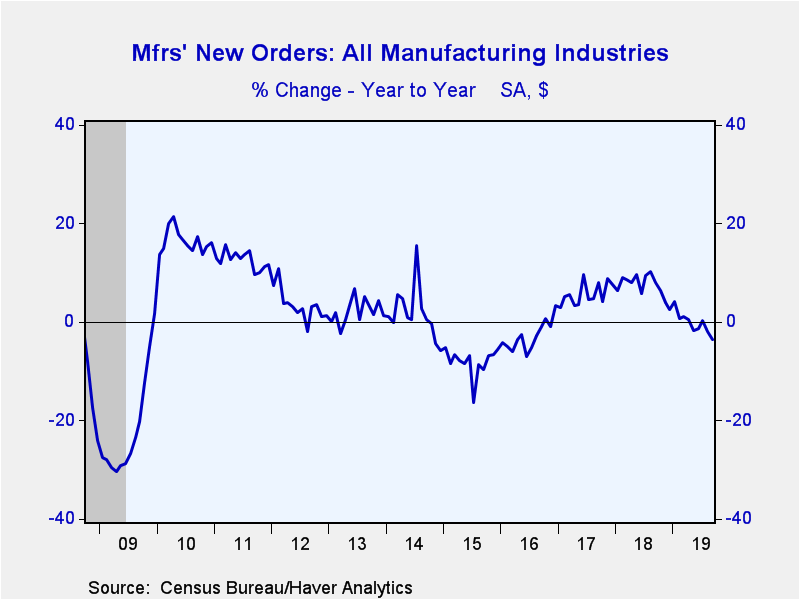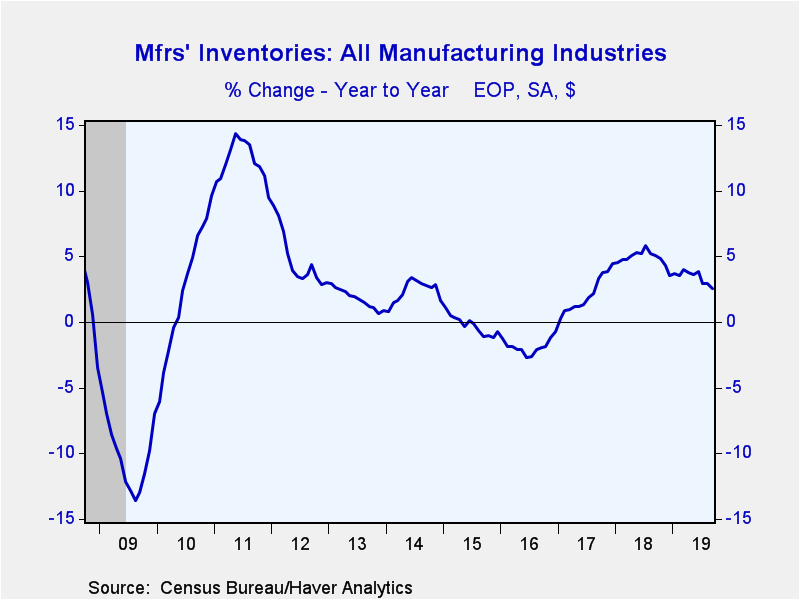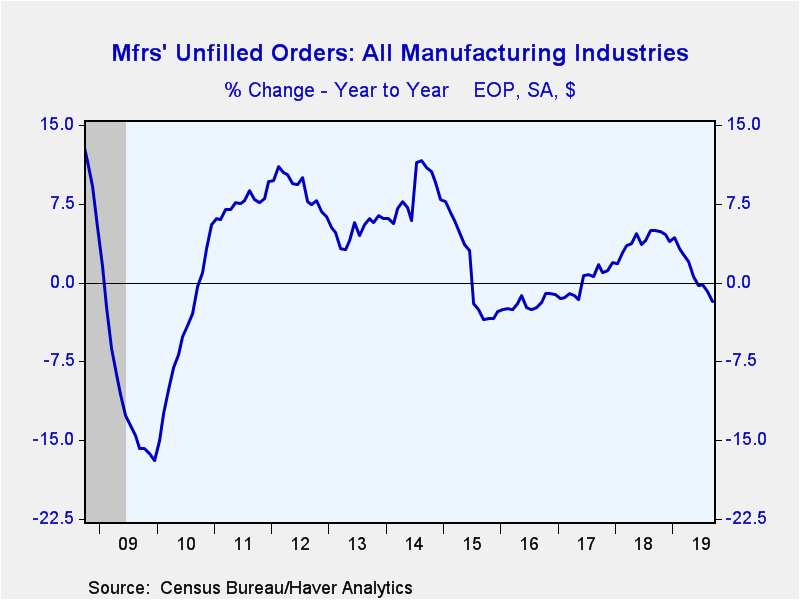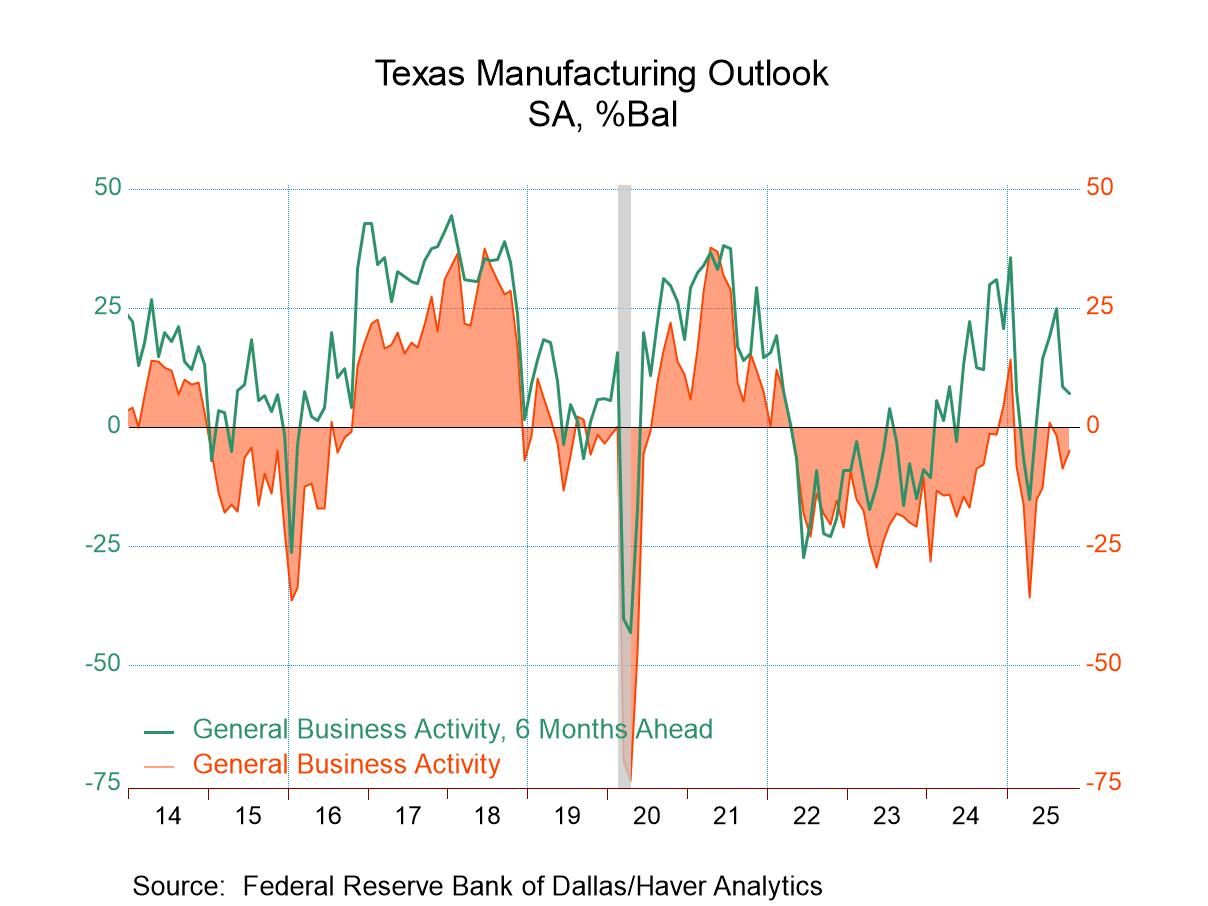 Global| Nov 04 2019
Global| Nov 04 2019U.S. Factory Sector Activity Weakens and Inventories Rise
by:Tom Moeller
|in:Economy in Brief
Summary
Factory orders fell 0.6% (-3.5%) in September following an unrevised 0.1% August dip. A 0.5% decline had been expected in the Action Economics Forecast Survey. Orders for durable goods fell 1.2% (-5.5% y/y), revised from the advance [...]
Factory orders fell 0.6% (-3.5%) in September following an unrevised 0.1% August dip. A 0.5% decline had been expected in the Action Economics Forecast Survey. Orders for durable goods fell 1.2% (-5.5% y/y), revised from the advance 1.1% shortfall. Leading the slide was an 11.8% drop in orders for nondefense aircraft. Orders for computers & electronic products also fell 1.2% (-0.3% y/y), but machinery orders gained 0.2% (-1.4% y/y). The new news in this report was that factory orders for nondurable goods, which equal shipments, rose a minimal 0.1% (-1.3% y/y). Overall nondurable goods were held back by a 0.5% decline (-3.8% y/y) in orders to textile mills. Textile product orders also fell 0.2% (-3.0% y/y). To the upside, chemical orders rose 0.2% (2.4% y/y) and paper product orders edged 0.1% higher (0.2% y/y) for the third month in the last four. Petroleum refinery orders gained 0.2% (-12.3% y/y).
Factory sector shipments overall eased 0.2% (-1.2% y/y) led by a 0.5% decline in durable goods shipments. That reflected a 3.4% fall (-5.0% y/y) in auto shipments, which were down sharply for the third straight month. Computer & electronic product shipments eased 0.4% (+1.9% y/y), off for the fourth consecutive month. These declines were accompanied by a 1.4% fall (-0.0% y/y) in shipments for machinery which roughly equaled the declines during the prior two months. Offsetting these declines was a 0.8% rise (2.1% y/y) in shipments of electrical equipment after falling for two straight months. Primary metals shipments rose 1.3% (-5.6% y/y) and fabricated metals shipments improved minimally (2.4% y/y).
Inventories in the manufacturing sector increased 0.3% following a 0.1% August decline. A 0.1% rise had been expected. The y/y increase decelerated to 2.6% from its peak of 5.8% in July of last year. A 1.5% increase (11.7% y/y) in transportation sector inventories led the rise. Auto inventories jumped 3.0% (24.3% y/y) and have risen strongly in all but one month this year. Nondefense aircraft inventories rose 2.1% (15.9% y/y). Outside the transportation sector, inventories held steady (0.4% y/y) following five straight months of decline. Inventories of computers & electronic products rose 0.4% (0.3% y/y) while machinery inventories were little changed (3.7% y/y). Inventories of nondurable goods edged 0.1% higher, but fell 0.7% y/y. Textile inventories rose 0.5% (-0.5% y/y). Basic chemical inventories rose 0.5% (1.4% y/y). Paper product inventories were off 0.2% (+1.7% y/y) and petroleum refinery inventories fell 0.9% (-11.1% y/y).
The level of unfilled orders in the factory sector held steady (-1.8% y/y) after two months of 0.1% increase. Outside of the transportation sector, order backlogs also remained unchanged (0.5% y/y). Machinery backlogs held steady (-3.2% y/y) while unfilled orders for computers & electronic product were similarly unchanged. Electrical equipment backlogs rose 0.2% (2.2% y/y) and unfilled orders of transportation equipment were unchanged (-2.8% y/y).
The factory sector figures are available in Haver's USECON database. The expectation figure is in the AS1REPNA database.
| Factory Sector (% chg) - NAICS Classification | Sep | Aug | Jul | Sep Y/Y | 2018 | 2017 | 2016 |
|---|---|---|---|---|---|---|---|
| New Orders | -0.6 | -0.1 | 1.4 | -3.5 | 7.3 | 5.7 | -2.9 |
| Shipments | -0.2 | -0.3 | -0.3 | -1.2 | 6.9 | 5.0 | -3.2 |
| Unfilled Orders | -0.0 | 0.1 | 0.1 | -1.8 | 3.9 | 1.9 | -1.1 |
| Inventories | 0.3 | -0.1 | 0.1 | 2.6 | 3.5 | 4.5 | -0.7 |
Tom Moeller
AuthorMore in Author Profile »Prior to joining Haver Analytics in 2000, Mr. Moeller worked as the Economist at Chancellor Capital Management from 1985 to 1999. There, he developed comprehensive economic forecasts and interpreted economic data for equity and fixed income portfolio managers. Also at Chancellor, Mr. Moeller worked as an equity analyst and was responsible for researching and rating companies in the economically sensitive automobile and housing industries for investment in Chancellor’s equity portfolio. Prior to joining Chancellor, Mr. Moeller was an Economist at Citibank from 1979 to 1984. He also analyzed pricing behavior in the metals industry for the Council on Wage and Price Stability in Washington, D.C. In 1999, Mr. Moeller received the award for most accurate forecast from the Forecasters' Club of New York. From 1990 to 1992 he was President of the New York Association for Business Economists. Mr. Moeller earned an M.B.A. in Finance from Fordham University, where he graduated in 1987. He holds a Bachelor of Arts in Economics from George Washington University.










